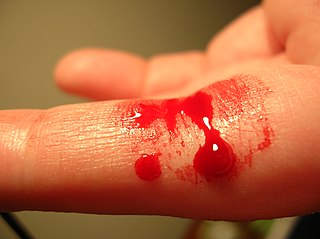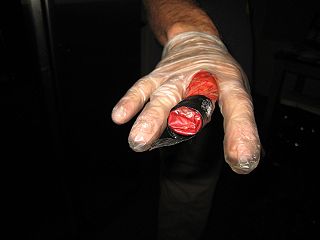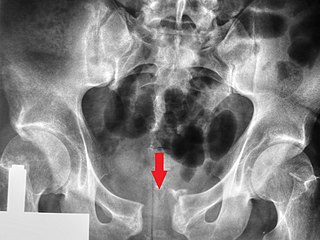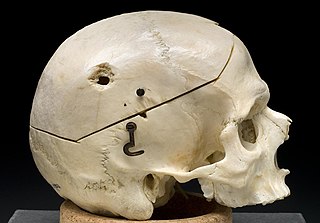Related Research Articles

Hypoxia is a condition in which the body or a region of the body is deprived of adequate oxygen supply at the tissue level. Hypoxia may be classified as either generalized, affecting the whole body, or local, affecting a region of the body. Although hypoxia is often a pathological condition, variations in arterial oxygen concentrations can be part of the normal physiology, for example, during strenuous physical exercise.

Bleeding, hemorrhage, haemorrhage or blood loss is blood escaping from the circulatory system from damaged blood vessels. Bleeding can occur internally, or externally either through a natural opening such as the mouth, nose, ear, urethra, vagina or anus, or through a puncture in the skin. Hypovolemia is a massive decrease in blood volume, and death by excessive loss of blood is referred to as exsanguination. Typically, a healthy person can endure a loss of 10–15% of the total blood volume without serious medical difficulties. The stopping or controlling of bleeding is called hemostasis and is an important part of both first aid and surgery.

Emergency tourniquets are cuff-like devices designed to stop severe traumatic bleeding before or during transport to a care facility. They are wrapped around the limb, proximal to the site of trauma, and tightened until all blood vessels underneath are occluded. The design and construction of emergency tourniquets allows quick application by first aid responders or the injured persons themselves. Correct use of tourniquet devices has been shown to save lives under austere conditions with comparatively low risk of injury. In field trials, prompt application of emergency tourniquets before the patient goes into shock are associated with higher survival rates than any other scenario where tourniquets were used later or not at all.

Battlefield medicine, also called field surgery and later combat casualty care, is the treatment of wounded combatants and non-combatants in or near an area of combat. Civilian medicine has been greatly advanced by procedures that were first developed to treat the wounds inflicted during combat. With the advent of advanced procedures and medical technology, even polytrauma can be survivable in modern wars. Battlefield medicine is a category of military medicine.

An injury is any physiological damage to living tissue caused by immediate physical stress. Injuries to humans can occur intentionally or unintentionally and may be caused by blunt trauma, penetrating trauma, burning, toxic exposure, asphyxiation, or overexertion. Injuries can occur in any part of the body, and different symptoms are associated with different injuries.
Hemicorporectomy is a radical surgery in which the body below the waist is amputated, transecting the lumbar spine. This removes the legs, the genitalia, urinary system, pelvic bones, anus, and rectum. It is a major procedure recommended only as a last resort for people with severe and potentially fatal illnesses such as osteomyelitis, tumors, severe traumas and intractable decubiti in, or around, the pelvis. By 2009, 66 cases had been reported in medical literature.

Major trauma is any injury that has the potential to cause prolonged disability or death. There are many causes of major trauma, blunt and penetrating, including falls, motor vehicle collisions, stabbing wounds, and gunshot wounds. Depending on the severity of injury, quickness of management, and transportation to an appropriate medical facility may be necessary to prevent loss of life or limb. The initial assessment is critical, and involves a physical evaluation and also may include the use of imaging tools to determine the types of injuries accurately and to formulate a course of treatment.

A blast injury is a complex type of physical trauma resulting from direct or indirect exposure to an explosion. Blast injuries occur with the detonation of high-order explosives as well as the deflagration of low order explosives. These injuries are compounded when the explosion occurs in a confined space.

Ahmad II ibn Ali, commonly known as Ahmed Bey, was the ruler of Tunisia from 11 February 1929 until his death. He was the son of Ali Muddat ibn al-Husayn.
Military anti-shock trousers (MAST), or pneumatic anti-shock garments (PASG), are medical devices used to treat severe blood loss. The device is usually applied to the patient's pelvis, abdomen, and lower parts of the body and is composed of man-made inflatable air bladders. The device is designed to transfer blood away from the above described body parts and into the upper body by applying pressure.

A pelvic fracture is a break of the bony structure of the pelvis. This includes any break of the sacrum, hip bones, or tailbone. Symptoms include pain, particularly with movement. Complications may include internal bleeding, injury to the bladder, or vaginal trauma.
Atlanto-occipital dislocation, orthopedic decapitation, or internal decapitation describes ligamentous separation of the spinal column from the skull base. It is possible for a human to survive such an injury; however, 70% of cases result in immediate death. It should not be confused with atlanto-axial dislocation, which describes ligamentous separation between the first and second cervical vertebra.

A gunshot wound (GSW) is a penetrating injury caused by a projectile from a gun. Damages may include bleeding, bone fractures, organ damage, wound infection, loss of the ability to move part of the body, and in severe cases, death. Damage depends on the part of the body hit, the path the bullet follows through the body, and the type and speed of the bullet. Long-term complications can include bowel obstruction, failure to thrive, neurogenic bladder and paralysis, recurrent cardiorespiratory distress and pneumothorax, hypoxic brain injury leading to early dementia, amputations, chronic pain and pain with light touch (hyperalgesia), deep venous thrombosis with pulmonary embolus, limb swelling and debility, and lead poisoning.

Penetrating trauma is an open wound injury that occurs when an object pierces the skin and enters a tissue of the body, creating a deep but relatively narrow entry wound. In contrast, a blunt or non-penetrating trauma may have some deep damage, but the overlying skin is not necessarily broken and the wound is still closed to the outside environment. The penetrating object may remain in the tissues, come back out the path it entered, or pass through the full thickness of the tissues and exit from another area.

A pulmonary contusion, also known as lung contusion, is a bruise of the lung, caused by chest trauma. As a result of damage to capillaries, blood and other fluids accumulate in the lung tissue. The excess fluid interferes with gas exchange, potentially leading to inadequate oxygen levels (hypoxia). Unlike pulmonary laceration, another type of lung injury, pulmonary contusion does not involve a cut or tear of the lung tissue.
Blast-related ocular trauma comprises a specialized subgroup blast injuries which cause penetrating and blunt force injuries to the eye and its structure. The incidence of ocular trauma due to blast forces has increased dramatically with the introduction of new explosives technology into modern warfare. The availability of these volatile materials, coupled with the tactics of contemporary terrorism, has caused a rise in the number of homemade bombs capable of extreme physical harm.
Prehospital ultrasound is the specialized application of ultrasound by physicians and other emergency medical services (EMS) to guide immediate care and treatment procedures. Like conventional ultrasound, it is a device that produces cyclic sound pressure to penetrate a medium and reveal details about the inner structure of the medium.
Damage control surgery (DCS) is surgical intervention to keep the patient alive rather than correct the anatomy. It addresses the "lethal triad" for critically ill patients with severe hemorrhage affecting homeostasis leading to metabolic acidosis, hypothermia, and increased coagulopathy.

Spinal precautions, also known as spinal immobilization and spinal motion restriction, are efforts to prevent movement of the spine in those with a risk of a spine injury. This is done as an effort to prevent injury to the spinal cord. It is estimated that 2% of people with blunt trauma will have a spine injury.

The Traumatic Brain Injury Reauthorization Act of 2013 is a bill that would reauthorize appropriations for Centers for Disease Control and Prevention (CDC) projects to reduce the incidence of traumatic brain injury and projects related to track and monitor traumatic brain injuries.
References
- ↑ Holcomb JB, McMullin NR, Pearse L, Caruso J, Wade CE, Oetjen-Gerdes L; et al. (2007). "Causes of death in U.S. Special Operations Forces in the global war on terrorism: 2001-2004". Ann Surg. 245 (6): 986–91. doi:10.1097/01.sla.0000259433.03754.98. PMC 1876965 . PMID 17522526.
{{cite journal}}: CS1 maint: multiple names: authors list (link) - ↑ https://www.jems.com/administration-and-leadership/proof-life-make-every-possible/
- ↑ "Indianapolis Journal 13 May 1902". Hoosier State Chronicles: Indiana's Digital Historic Newspaper Program. 1902-05-13. Retrieved 2020-09-17.
- ↑ Kristi L. Koenig; Carl H. Schultz (18 April 2016). Koenig and Schultz's Disaster Medicine: Comprehensive Principles and Practices. Cambridge University Press. pp. 469–470. ISBN 978-1-316-47292-7.
- ↑ Champion HR, Holcomb JB, Young LA (2009). "Injuries from explosions: physics, biophysics, pathology, and required research focus". J Trauma. 66 (5): 1468–77, discussion 1477. doi:10.1097/TA.0b013e3181a27e7f. PMID 19430256.
{{cite journal}}: CS1 maint: multiple names: authors list (link) - ↑ https://scmh.org/wp-content/uploads/2014/01/DeadonScene.pdf
- ↑ http://www.ocmca.org/wp-content/uploads/2018-Protocols/Section-7-Procedures/7.6-Patient-Death-Termination-of-Resusitation-and-Pronouncement.pdf
- ↑ Jones, Chris (November 2009). "The Things That Carried Him". In American Society of Magazine Editors (ed.). The Best American Magazine Writing 2009. Columbia University Press. p. 85. ISBN 978-0-231-14796-5.